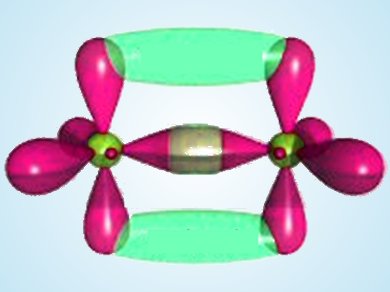Linus Carl Pauling was born in Portland, Oregon, USA, on February 28, 1901. After showing an early interest in chemistry, he became one of the most sucessful scientists in the 20th century.
Linus Pauling received his B.Sc. in chemical engineering from Oregon State College, Corvallis, USA, in 1922. To fund his studies, he also worked as a teacher of quantitative analysis at Oregon State College from 1919–1920. In 1922, he was appointed as a teaching fellow in chemistry at the California Institute of Technology (Caltech), Pasadena, USA. Here, he carried out doctoral research into the use of X-ray diffraction to determine the structure of crystals under the guidance of Professors Roscoe G. Dickinson and Richard C. Tolman, and he obtained his Ph.D in 1925.
In 1926, he was awarded a Guggenheim Fellowship, with which he traveled to Europe. During this period he furthered his interest and knowledge in quantum mechanics by working with Arnold Sommerfeld in Munich, Germany, Niels Bohr in Copenhagen, Denmark, and Erwin Schrödinger in Zürich, Switzerland. Pauling returned to Caltech, in 1927, as an assistant professor in theoretical chemistry. He was later promoted to associate professor and then full professor, in 1931. In the same year, Pauling became the first recipient of the American Chemical Society’s Langmuir Prize for the most significant work in pure chemistry by a person aged 30 or younger.
On starting his independent career, in 1927, Pauling continued with his X-ray crystal studies, but inspired by his time in Europe, he started to look at quantum mechanical calculations to investigate the formation of chemical bonds between atoms in molecules and crystals. It was during this period that he came up with the concepts of electronegativity, orbital hybridization, and resonance. This work eventually led to him publishing one of the most influential chemistry books: “The Nature of the Chemical Bond” and to him being awarded the Nobel Prize in Chemistry in 1954 “for his research into the nature of the chemical bond and its application to the elucidation of the structure of complex substances” [1].
In the mid-1930s, Pauling’s focus moved from inorganic molecules to molecules of biological importance, thus changing to the field of biochemistry. He initially studied the structure of hemoglobin and later he discovered that the disease sickle cell anemia is molecular in origin, being caused by a defect in the hemoglobin of red blood cells.
In 1964, Pauling won the Nobel Peace Prize for his opposition to weapons of mass destruction and, thus, became the first, and so far the only, person to be awarded two unshared Nobel Prizes.
Later on in his career, Pauling’s resarch on Vitamin C caused much controversy and he was a fierce opponent of the concept of quasicrystals. Pauling died, at the age of 93, on August 19, 1994, in Big Sur, CA, USA.
Linus Carl Pauling is the answer to Guess the Chemist (32)
[1] Linus Pauling, The Nature of the Chemical Bond and the Structure of Molecules and Crystals, 3rd Edition, Cornell University Press, USA, 1960. ISBN: 978-0801403330
Source:
- Linus Pauling Biography, Oregonstate.edu, accessed May 16, 2014. Link


